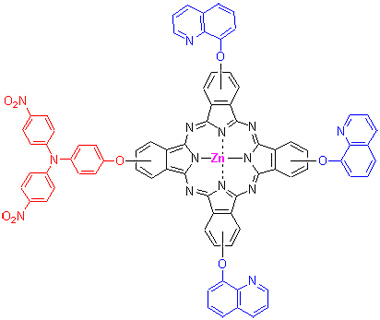| [1] O′regan, B.; Grätzel, M. Nature 1991, 353, 737. [2] Hagfeldt, A.; Grätzel, M. Chem. Rev. 1995, 95, 49. [3] Dai, S., Y.; Wang, K., J.; Weng, J.; Sui, Y., F.; Huang, Y.; Xiao, S., F. Solar Energy Mater. Solar Cells 2005, 85, 447. [4] Horiuchi, T.; Miura, H.; Uchida, S. J. Photochem. Photobiol. A: Chem. 2004, 164, 29. [5] Li, C., Y.; Yang, X., C.; Chen, R., K.; Pan, J., X; Tian, H., N.; Zhu, H., J.; Wang, X., N.; Hagfeldt, A.; Sun, L., C. Solar Energy Mater. Solar Cells 2007, 91, 1863. [6] Qin, H.; Wenger, S.; Xu, M.; Gao, F.-F.; Jing, X.-Y.; Wang, P.; Zakeeruddin, S. M.; Grätzel, M. J. Am. Chem. Soc. 2008, 130, 9202. [7] Dastoor, P. C.; McNeill, C. R.; Frohne, H.; Foster, C. J.; Dean, B.; Fell, C. J.; Belcher, W. J.; Campbell, W. M.; Officer, D. L.; Blake, L. M.; Thordarson, P.; Crossley, M. J.; Hush, N. S.; Reimers, J. R. J. Phys. Chem. C 2007, 111, 15415. [8] Deng, H.-H.; Mao, H.-F.; Shen, Y.-C.; Lu, Z.-H.; Xu, H.-J. Acta Chim. Sinica 1999, 57, 1199 (in Chinese).(邓慧华, 毛海舫, 沈耀春, 陆祖宏, 许慧君, 化学学报, 1999, 57, 1199.) [9] Hou, Y. J.; Xie, P. H.; Zhang, B. W.; Cao, Y.; Xiao, X. R.; Wang, W. B. Inorg. Chem. 1999, 38, 6320. [10] Clifford, J. N.; Palomares, E.; Nazeeruddin, M. D. K.; Thampi, R.; Grätzel, M.; Durrant, J. R. J. Am. Chem. Soc. 2004, 126, 5670. [11] Kong, F.-T.; Dai, S.-Y.; Wang, K.-J. Chemistry 2005, (5), 338 (in Chinese).(孔凡太, 戴松元, 王孔嘉, 化学通报, 2005, (5), 338.) [12] Wu, D.; Shen, Z.; Xue, Z.-L.; You, X., Z. Chin. J. Inorg. Chem. 2007, 23, 1 (in Chinese).(吴迪, 沈珍, 薛兆历, 游效曾, 无机化学学报, 2007, 23, 1.) [13] Wang, Q.; Campbell, W. M.; Bonfantani, E. E.; Jolley, K. W.; Officer, D.; Walsh, P. J.; Gordon, K.; Baker, R. H.; Nazeeruddin, M. K.; Grätzel, M. J. Phys. Chem. B 2005, 109, 15397. [14] Chen, W.; Duan, W.-B.; He, C.-Y.; Zuo, X.; Wu, Y.-Q. Chin. J. Inorg. Chem. 2005, 21, 1880 (in Chinese).(陈伟, 段武彪, 贺春英, 左霞, 吴谊群, 无机化学学报, 2005, 21, 1880.) [15] Hammer, R. P.; Owens, C. V.; Hwang, S. H.; Sayes, C. M.; Soper, S. A. Bioconjugate Chem. 2002, 13, 1244. [16] Campbell, W. M.; Jolley, K. W.; Wagner, P.; Wagner, K.; Walsh, P. J.; Gordon, K. C.; Mende, L. S.; Nazeeruddin, M. K.; Wang, Q.; Grätzel, M.; Officer, D. L. J. Phys. Chem. C 2007, 111, 11760. [17] Bai, Q.-L.; Zhang, C.-H.; Cheng, C.-H.; Li, W.-C.; Du, G.-T. Acta Chim. Sinica 2011, 69, 949 (in Chinese).(白青龙, 张春花, 程传辉, 李万程, 杜国同, 化学学报, 2011, 69, 949.) [18] Yu, X.-W.; Zhan, C.-L.; Huang, Y. Chin. J. Org. Chem. 2012, 32, 770 (in Chinese).(俞孝伟, 詹传郎, 黄彦, 有机化学, 2012, 32, 770.) [19] Zhang, D.; Zhang, X.-J.; Zhang, L.; Mao, L.-J. Bull. Korean Chem. Soc. 2012, 33, 1 [20] Pei, J. Ph.D. Dissertation, Nankai University, Tianjin, 2009 (in Chinese).(裴娟, 博士论文, 南开大学, 天津, 2009.) [21] Peng, Y.-R.; Huang, F.-H. Strait Pharm. J. 2003, 15, 53 (in Chinese).(彭亦如, 黄风华, 海峡药学, 2003, 15, 53.) [22] Liu, Q.-H.; Fu, Q.; Yang, J.; Ma, J.-C.; Li, W.-L.; Wang, X. J. Mol. Struct. 2010, 963, 41 [23] Yenilmez, H.-Y.; özcesmeci, ?.; Okur, A. ?.; Gül, A. Polyhedron 2004, 23, 787. [24] Liu, L.-W. M.S. Thesis, Zhejiang University, Hangzhou, 2008 (in Chinese). (刘立维, 硕士论文, 浙江大学, 杭州, 2008.) [25] Li, W.-L. M.S. Thesis, Northeast Normal University, Changchun, 2010 (in Chinese).(李伟利, 硕士论文, 东北师范大学, 长春, 2010.) [26] Sastre, A.; Torres, T.; Hanack, M. Tetrahedron Lett. 1995, 36, 8501. [27] Zhang, X.-J.; Mao, L.-J.; Zhang, D.; Zhang, L. J. Mol. Struct. 2012, 1022, 153. [28] Giribabu, L.; Vijay, K. C.; Gopal, R. V.; Yella, R. P. Solar Energ. Mater. Solar Cells 2007, 91, 1611. [29] Hagfeldt, A.; Grätzel, M. Chem. Rev. 1995, 95, 49. [30] Liu, L.-W.; Shi, M.-M.; Deng, D.; Wang, M.; Chen, H.-Z. Acta Chim. Sinica 2008, 66, 2163 (in Chinese).(刘立维, 施敏敏, 邓丹, 汪茫, 陈红征, 化学学报, 2008, 66, 2163.) [31] Zhang, T.-L.; Yan, J.-M. Acta Chim. Sinica 2000, 58, 981 (in Chinese). (张天莉, 严继民, 化学学报, 2000, 58, 981.) |
